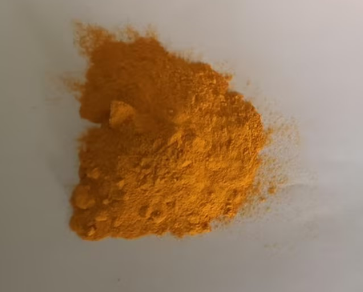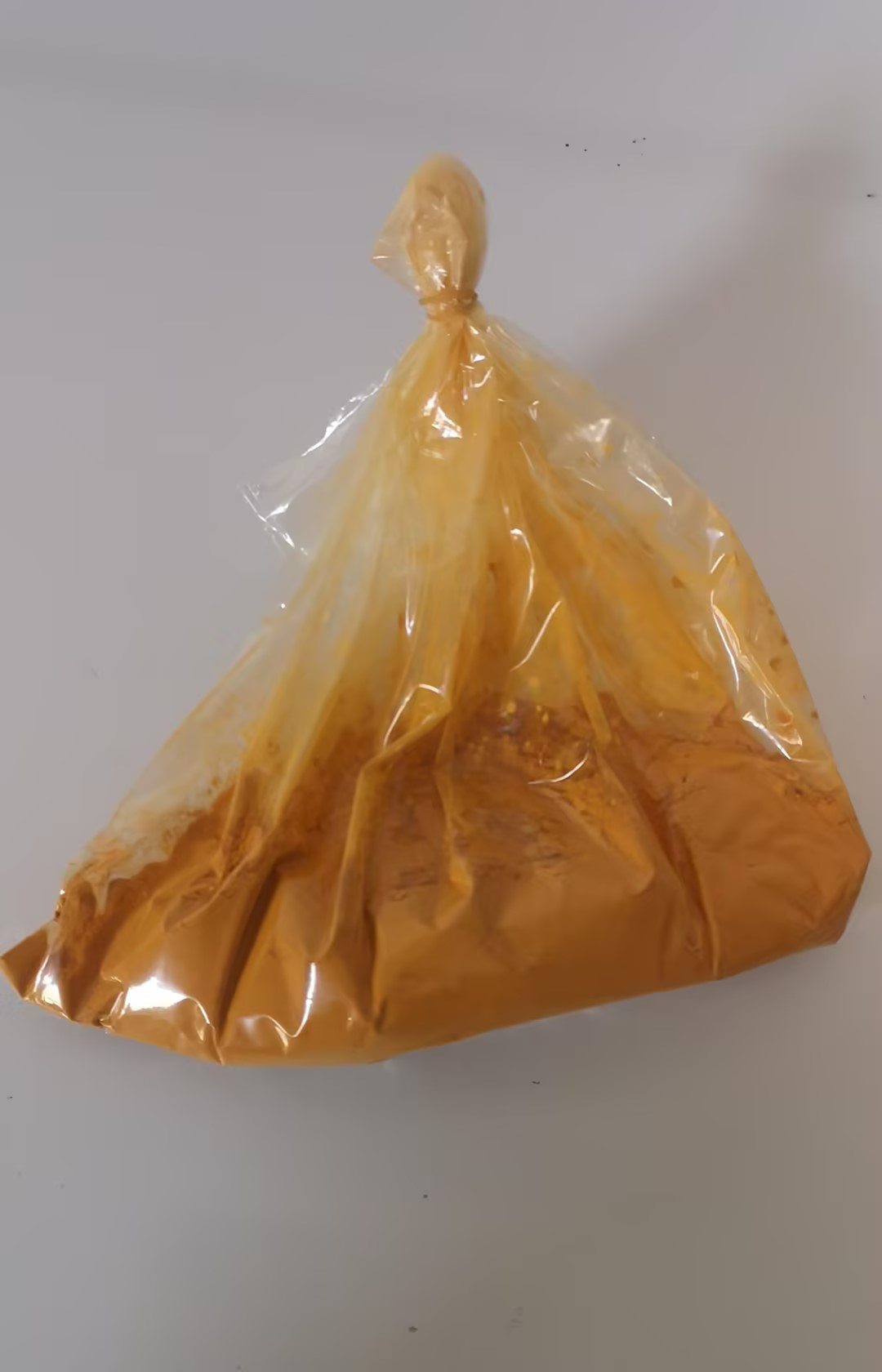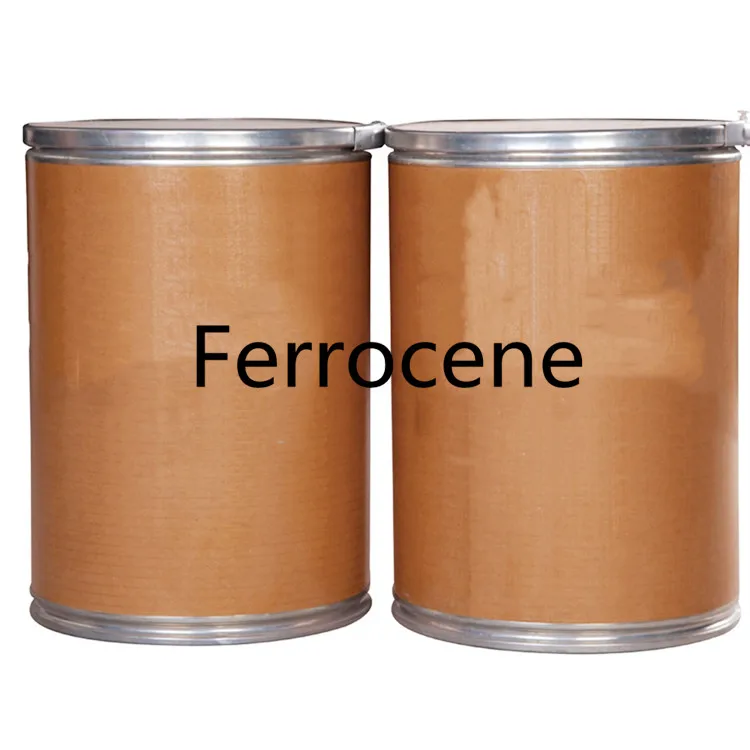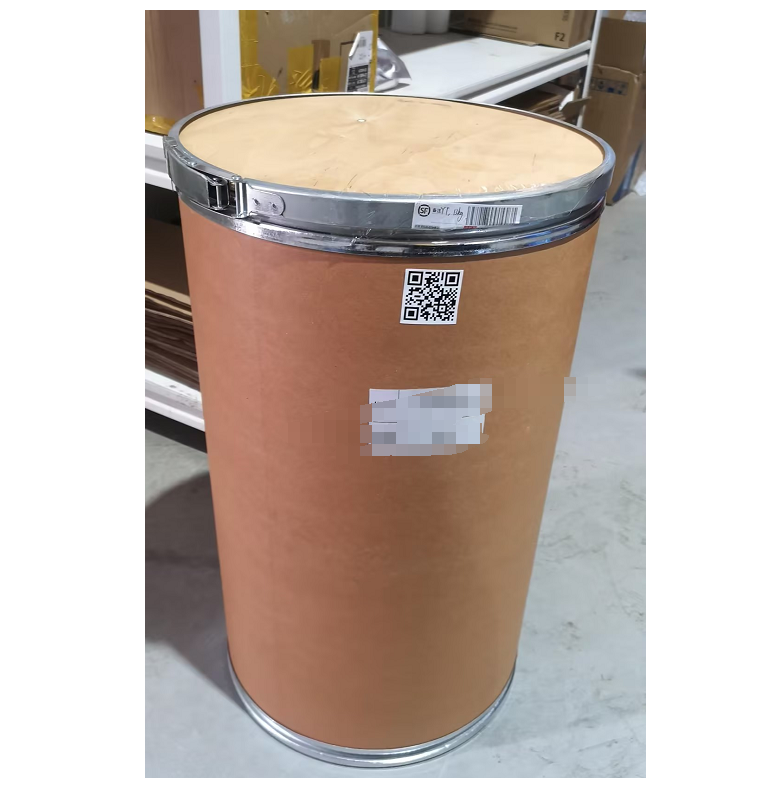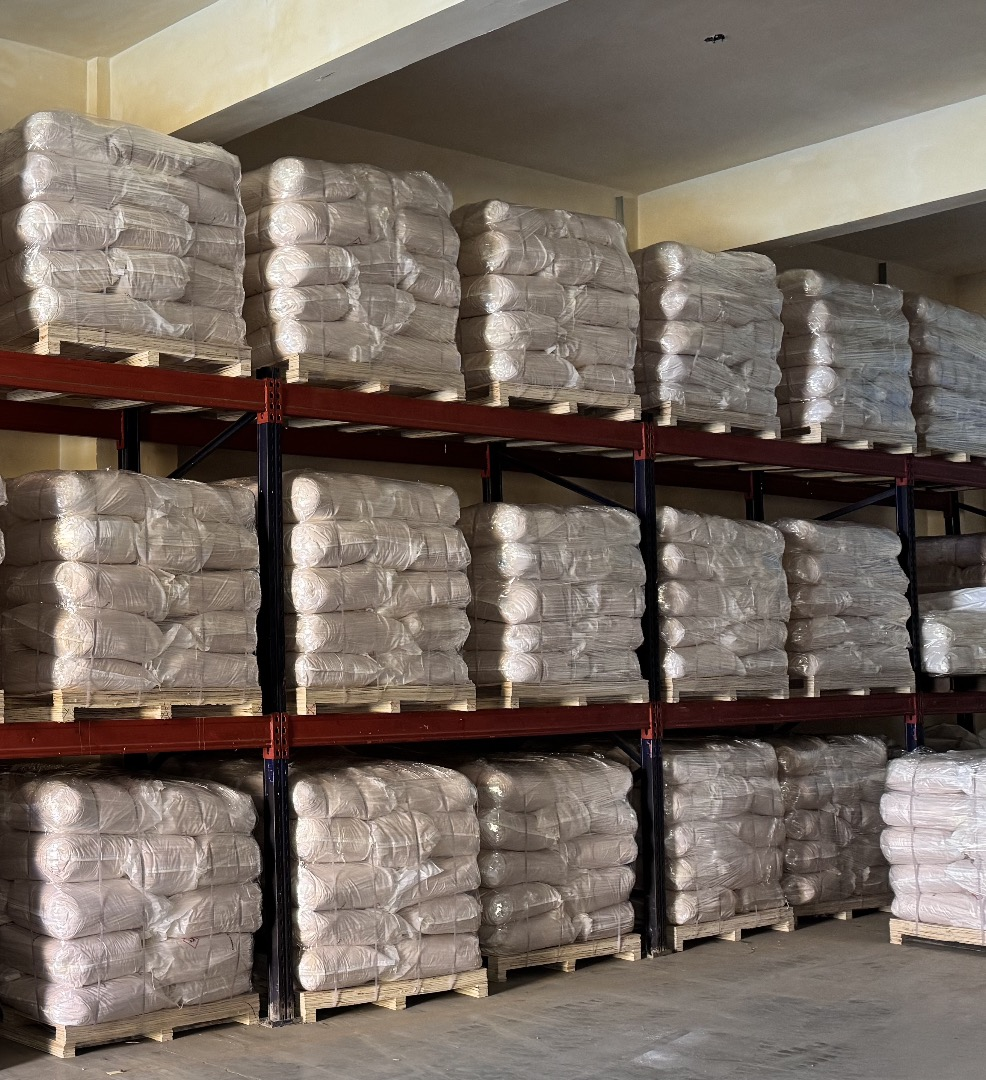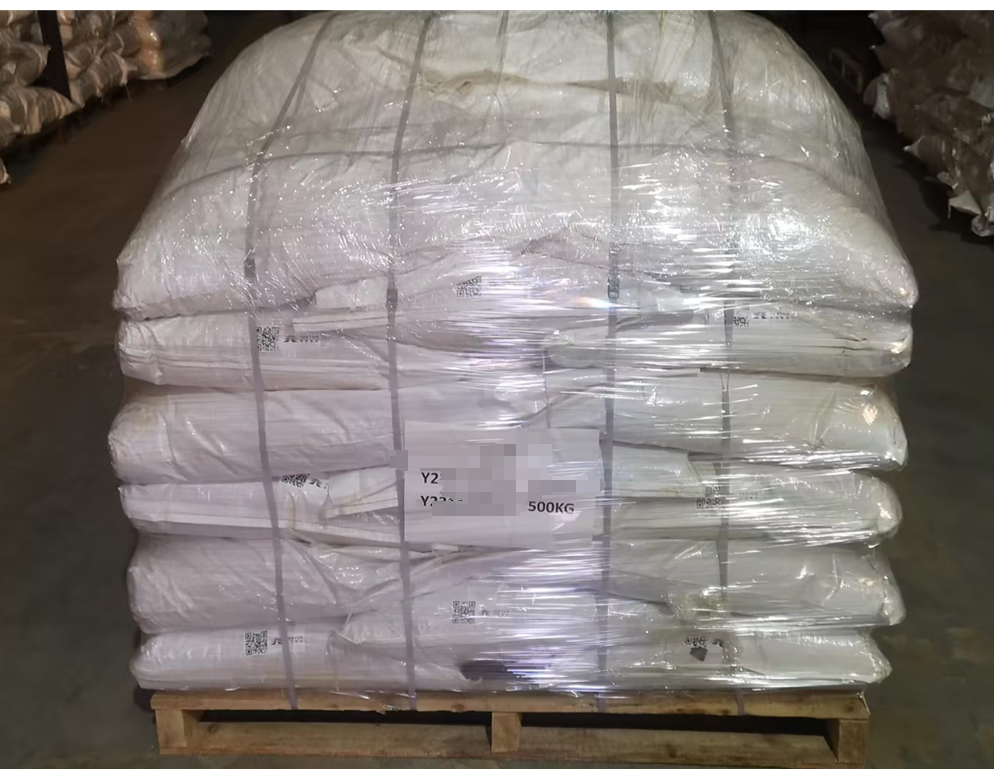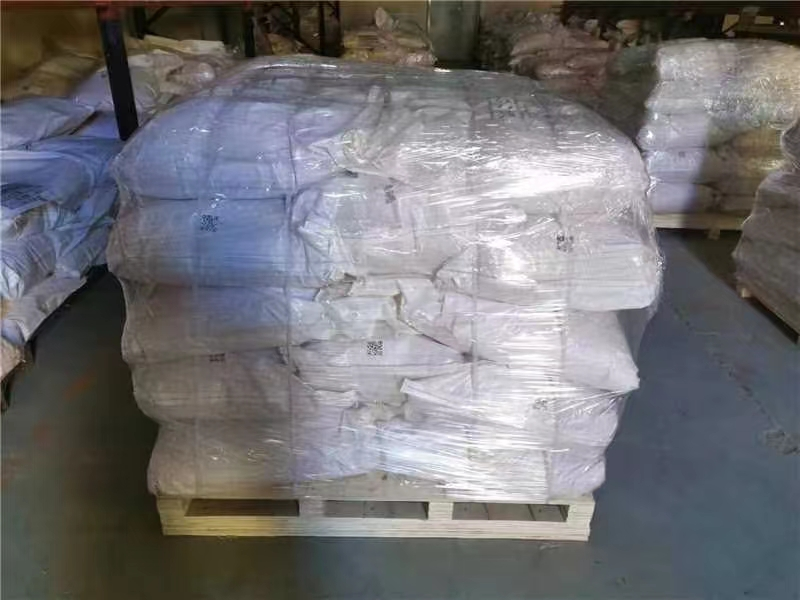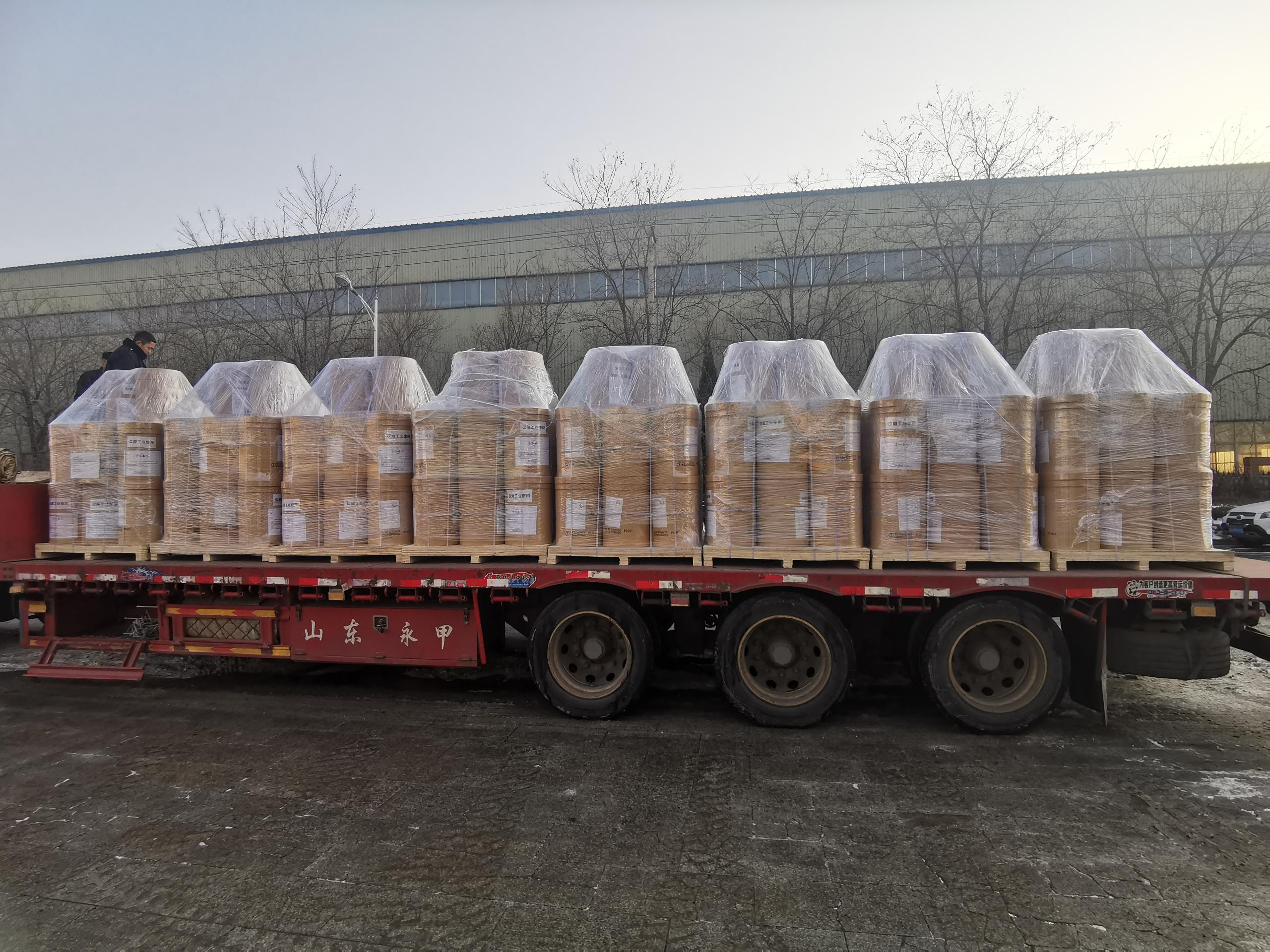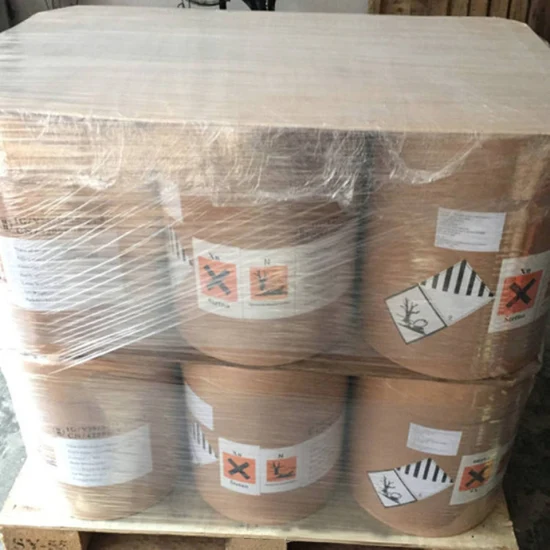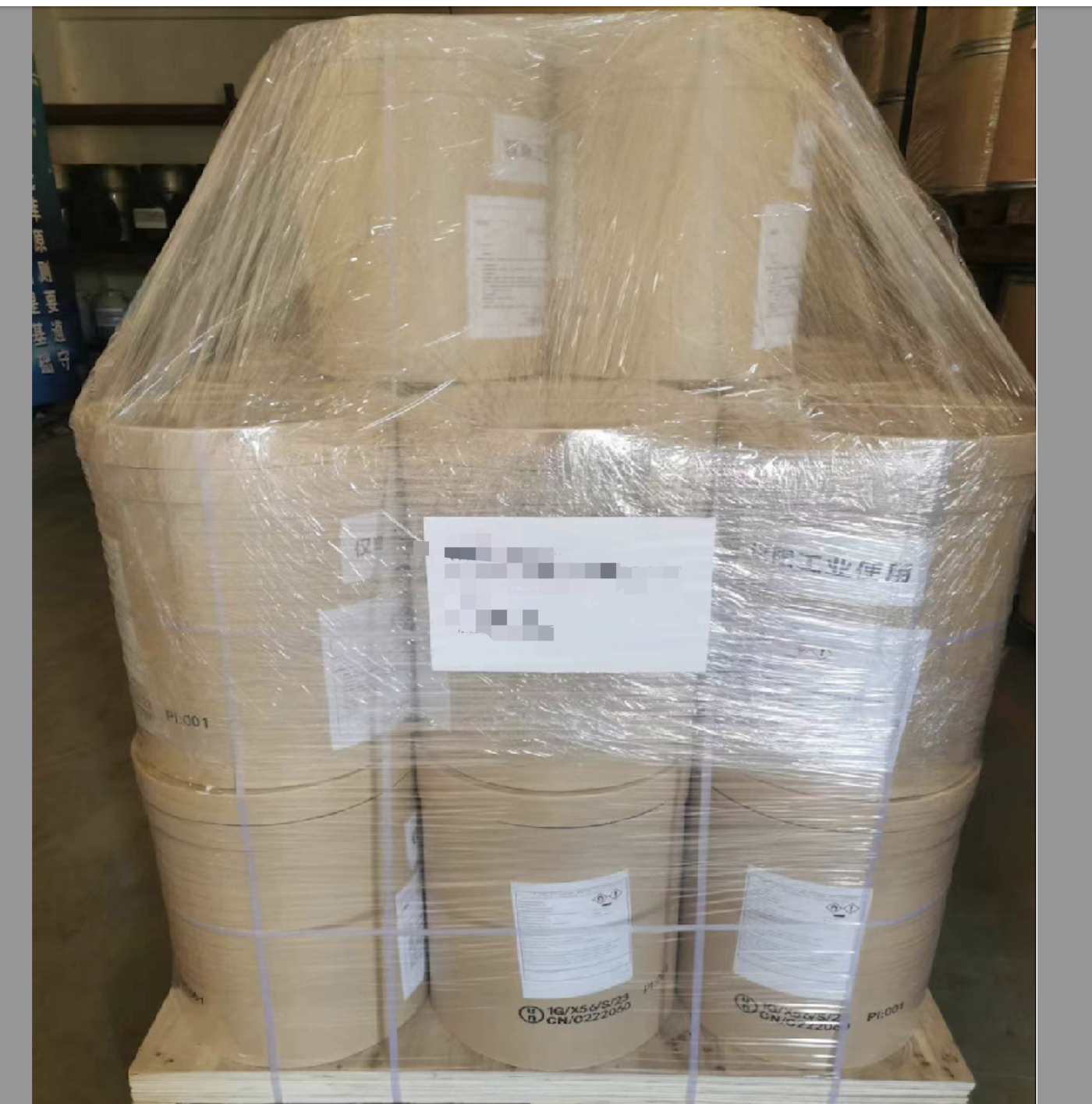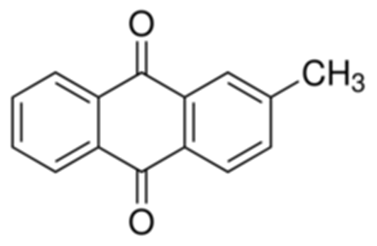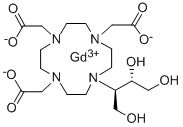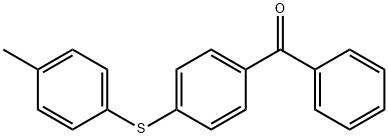Ferrocene literature
Homoleptic complexes of cobalt(0) and nickel(0,I) with 1,1′- bis(diphenylphosphino)ferrocene (dppf): Synthesis and characterization
Pilloni, Giuseppe,Toffoletti, Antonio,Bandoli, Giuliano,Longato, Bruno
, p. 10321 - 10328 (2006)
Reduction of Co(dppf)Cl2 with 2 equiv of sodium naphthalenide in THF, in the presence of dppf, affords the homoleptic complex Co(dppf) 2, 1, isolated in 65% yield as a brick red solid, extremely air sensitive. In solution, under inert atmosphere, 1 slowly decomposes into Co and dppf, following a first-order kinetic law (t1/2 = 21 h at 22°C). Similarly to the Rh and Ir congeners, 1 undergoes a one-electron reversible reduction to [Co(dppf)2]-. Attempts to obtain this d 10 species by chemical as well as electrochemical reduction of 1 lead to the hydride HCo(dppf)2, 2, as the only product that can be isolated. Reduction of Ni(dppf)Cl2 with sodium in the presence of dppf and catalytic amounts of naphthalene affords Ni(dppf)2, 3, isolated in 60% yield as a yellow air stable solid. The stoichiometric oxidation of 3 with [FeCp2]PF6 forms the d9 complex [Ni(dppf)2]PF6, 4, which represents the second example of a structurally characterized Ni(I) complex stabilized by phosphines. A single-crystal X-ray analysis shows for the metal a distorted tetrahedral environment with a dihedral angle defined by the planes containing the atoms P(1), Ni, P(2) and P(3), Ni, P(4) of 78.2° and remarkably long Ni-P bond distances (2.342(3)-2.394(3) A). The EPR spectroscopic properties of 1 (at 106 K in THF) and 4 (at 7 K in 2-methyl-THF) have been examined and g tensor values measured (1, gx = 2.008, gy = 2.182, gz = 2.326; 4, gx = 2.098, gy = 2.113, gz = 2.332). A linear dependence between the hyperfine constants and the Ni-P bond distances has been evidenced. Finally, the change with time of the EPR spectrum of 4 indicates that it very slowly releases dppf.
Reactivity of an early-late heterobimetallic complex toward phosphines: Synthesis, structure, and reactivity of a cationic tantalum-palladium compound with a free cyclopentadienyl counteranion
Butts, Matthew D.,Bergman, Robert G.
, p. 4269 - 4271 (1993)
Treatment of Cp2Ta(CH2)(CH3) with CpPd-(C3H5) led to Cp2Ta(μ-CH2)2PdCp(1). Reaction of 1 with 1 equiv of either PMe3 or P(OMe)3 in CH2Cl2 resulted in the formation of Cp2Ta(μ-CH2)2Pd(PR3)(Cl) (R = Me, 2; R = OMe, 3) and 0.5 equiv of Cp2(CH2). The reaction of 1 with 2 equiv of PMe3 or P(OMe)3 or 1 equiv of Me2P(CH2)2PMe2 (DMPE) led to the isolation of [Cp2-Ta(μ-CH2)2PdL2]Cl (L2 = 2 PMe3, 4; L2 = 2 P(OMe)3, 5; L2 = DMPE, 6). Addition of P(OMe)3 to 1 in CH3CN gave the product Cp2Ta(μ-CH2)2Pd(P(OMe)3)(CH 2CN) (7). Each of these reactions of 1 with phosphorus compounds implicates the intermediacy of free cyclopentadienyl onion. In support of this hypothesis, the stable naked Cp complex [Cp2Ta(μ-CH2)2Pd(DMPE)]Cp (8) was isolated from the reaction of 1 with DMPE in CH3CN and was characterized by X-ray crystallography. The shortest distance between the free anionic Cp group and the bimetallic fragment in 8 is 3.46(3) A. Addition of FeCl2 to 8 resulted in the formation of 1/2 equiv of Cp2Fe and 6. Treatment of 8 with 1,2-dibromoethane led to the quantitative formation of 1/2 equiv of spiro[2.4]hepta-4,6-diene together with the bromide salt of 8.
Unusual reactivities of (μ-η2:η2-FP-C<*>C-H)Co2(CO)6, the adducts of FP-C<*>C-H to Co2(CO)8: photolysis, thermolysis and reduction with hydrosilanes giving polynuclear complexes, (CP)2Fe2Co3(μ5-C=CH)(CO)10, (μ-CH=CH)<(-μ3-C)Co3(CO)9>2 and CpFeCo3(μ-C=CH2)(CO)9
Akita, Munetaka,Terada, Masako,Ishii, Naomi,Hirakawa, Hideki,Moro-oka, Yoshihiko
, p. 175 - 186 (1994)
The properties and reactivities of (μ-η2:η2-FP-C<*>C-H)Co2(CO)6 (3) C-H adducts to Co2(CO)8: 3a (FP = Fp), 3b (FP = Fp*)> have been compared with those of alkyne adducts (μ-η2:η2-R-C<*>C-R)Co2(CO)6 and the Ph analogue (μ-η2:η2-Fp-C<*>C-Ph)Co2(CO)6 (5).Compound 3 has been shown to serve as a building block for polynuclear complexes. 13CO-labelling experiments on 3a and 5 have revealed an intramolecular exchange between the Fe-CO and Co-CO ligands.Photolysis of 3a, b produces pentanuclear clusters (CP)2Fe2Co3(μ5-C=CH)(CO)10 (11a,b), respectively, via an apparent addition reaction of a (CP)FeCo(CO)n fragment to 3.On the other hand, thermolysis of 3a gives the Fe-free hexacobalt cluster compound (μ-C=CH)<(-μ3-C)Co3(CO)9>2 (13) which consists of two alkylidyne tricobalt units linked by the CH=CH bridge, whereas 3b is thermolyzed to give the Fe-Co dimer without the C2H ligand, Cp*Fe(CO)(μ-CO)2Co(CO)3 (14), in addition to the photolysis product 11b.Reduction of 3 with hydrosilanes gives a mixture containing 1,2-disilylethylene (16) and the tetranuclear μ-vinylidene cluster CpFeCo3(μ4-C=CH2)(CO)9 (12) formally by way of hydrosilylation and hydrometallation (with a HCo(CO)n species) of the C2H ligand, respectively.In the case of the Pauson-Khand reaction and catalytic cyclotrimerization 3a exhibits reactivities similar to alkyne adducts to give the tricyclic cyclopentenone derivatives 18 (from norbornene and norbornadiene) and triphenylbenzenes, respectively. Key words: Iron; Cobalt; Carbonyl; Polynuclear
Oxidatively induced nucleophilic capture vs. degradation of cyclopentadienyl iron derivatives of simple carboxylic acids and of α-amino acids. A comparative study
Amiens, C.,Balavoine, G.,Guibe, F.
, p. 207 - 219 (1993)
The electrochemical behaviour and the chemical oxidation of various cyclopentadienyl iron complexes of simple carboxylic acids and of amino-protected α-amino acids have been studied in relation to several factors including the nature of the ligands on the metal (Cp, Cp*, CO, PPh3), the nature of the oxidizing agent (one-electron oxidants such as Cu(OTf)2, FcOTf and CAN or a two-electron oxidant such as NBS) and the medium effects (especially the presence or absence of nucleophilic species).With simple carboxylic acid derivatives either homolytic dissociation (leading to alkyl radicals) or nucleophilic capture of the first-formed iron radical cations is observed, depending on the reaction conditions.With α-amino acid derivatives, an oxidative degradation to aldehyde is observed invariably, which is likely to proceed through the successive and transient formation of N-acyl α-amino radicals and N-acyl iminium ions.
Multinuclear complexes derived from ferrocenylphosphines and triruthenium dodecacarbonyl
Zheng, Tu Cai,Cullen, William R.,Rettig, Steven J.
, p. 3594 - 3604 (1994)
Pyrolysis of Ru3(CO)11(PFc2Ph) in hexanes for 15 h gave the trinuclear cluster Ru3(CO)8-(μ-CO)(μ-H)[μ-η 3-(η5-C5H3PFcPh)Fe(η 5-C5H5)] (11) in 20% yield. Pyrolysis of Ru3(CO)12 with PFc2Ph in octane for 3.5 h gave the tetranuclear cluster Ru4(CO)11(μ3-PFc)(μ-η 1:η5-C5H4 (12) in 12% yield and the previously known 8, Ru4(CO)10(μ-CO)μ4-PFc)(μ 4-C6H4), in 10% yield: the mild conditions are noteworthy. Pyrolysis of Ru3(CO)12 with PEt2Fc in octane for 18 h gave the hexanuclear cluster complexes Ru6C(CO)14(μ-PEt2)2 (13) and Ru6C(CO)13(μ-PEt2)-(η5-C 5H5) (14) in 15% and 25% yields, respectively, and the pentanuclear derivative Ru5-(CO)9(μ-CO)(η6-C6H 6)2(μ4-PEt) (15) (low yield). Pyrolysis of Ru3(CO)12 with PEtFc2 in toluene for 10 h gave the pentanuclear cluster Ru5(CO)12(μ4-PEt)(η6-C 7H8) (16) in ~5% yield. Crystal data: 8, monoclinic, space group P21/c, a = 14.725(3) A?, b = 9.024(2) A?, c = 22.719(1) A?, β = 92.078(8)°, Z = 4; 11, triclinic, P1, a = 12.7671(9) A?, b = 13.284(1) A?, c = 10.2212(8) A?, α = 93.006(6)°, β = 98.561(6)°, γ = 83.665(6)°, Z = 2; 12, monoclinic, space group P21/c, a = 10.463(2) A?, b = 16.412(1) A?, c = 17.903(2) A?, β = 103.85(1)°, Z = 4; 13, monoclinic, space group C2/c, a = 12.566(2) A?, b = 16.326(2) A?, c = 17.001(2) A?, β = 105.43(1)°, Z = 4; 14, monoclinic, space group P21/c,a = 12.638(2) A?, b = 9.911(3) A?, c = 24.743(5) A?, β = 91.33-(2)°, Z = 4; 15, orthorhombic, space group Cmc21, a = 16.239(1) A?, b = 13.754(2) A?, c = 11.895(2) A?, Z = 4; 16, monoclinic, space group C2/c, a = 31.831(3) A?, b = 9.904(2) A?, c = 17.536(2) A?, β = 99.36(1)°, Z = 8. The structures were solved by direct or Patterson methods and were refined by full-matrix least-squares procedures to R = 0.042, 0.024, 0.027, 0.024, 0.028, 0.032, and 0.026 for 4943, 8583, 5279, 3650, 6357, 1302, and 5711 reflections with I ≥ 3σ(I), respectively.
AZOLE ANIONS AS ONE-ELECTRON REDUCERS OF FERRICINIUM SALTS
Babin, V. N.,Belousov, Yu. A.,Lyatifov, I. R.,Materikova, R. B.,Gumenyuk, V. V.
, p. C11 - C12 (1981)
Azole anions are capable of reducing ferricinium cation to ferrocene in solution at room temperature.Th formation of azolyl radicals under these conditions is detected.
Ferrocenylaluminum-pyridine adducts, lithium tetra(ferrocenyl)alanate, and the molecular structure of tri(ferrocenyl)aluminum-pyridine
Wrackmeyer, Bernd,Klimkina, Elena V.,Ackermann, Tamara,Milius, Wolfgang
, p. 3941 - 3948 (2009)
Aluminum compounds with up to four ferrocenyl groups (Fc) linked to aluminum were prepared and characterized in solution by NMR spectroscopy (1H, 13C, 27Al NMR), and in one case, tri(ferrocenyl)aluminum-pyridine Fc3
THE APPLICATION OF 13C AND 1H NMR SPECTROSCOPY TO THE INVESTIGATION OF THE DINITROGEN FIXATION PROCESS IN THE SYSTEM (η-C5H5)2TiCl2-Mg
Sobota, Piotr,Janas, Zofia
, p. 35 - 44 (1983)
The N2 reduction reaction in the system (η-C5H5)2TiCl2-Mg in tetrahydrofuran was examined.The 13C and 1H NMR results as well as the chemical properties of the products formed revealed that the reaction yielded a mixture of compounds in which the titanium atom was bonded both to the μ-(η5: η5-fulvalene) ligand and to the cyclopentadienyl ligands.In this system dinitrogen undergoes reduction to N3-, which then forms M3N bridges (M = Ti, Mg).The nitride nitrogen may readily be oxidized to imide nitride N-1, which may react further, e.g. with carbon monoxideto produce isocyanates, or, with excess oxidizing agent N2.THF in this system undergoes polymerisation.In addition, a - OC4H9 alkoxy group is formed which makes the substitution of the cyclopentadienyl group bonded to the titanium atoms possible.
Oxidation and Protonation of Transition Metal Hydrides: Role of an Added Base as Proton Shuttle and Nature of Protonated Water in Acetonitrile
Alessandra Quadrelli,Kraatz, Heinz-Bernhard,Poli, Rinaldo
, p. 5154 - 5162 (1996)
The Cp2Fe+ oxidation and the protonation of CpMoH(CO)2L (L: PPh3, 1; PMe3, 2) in MeCN have been investigated. In the dry solvent, the oxidation of both compounds consumes 1 mol of oxidant/mol of hydride with production of [CpMo(CO)2L(MeCN)]+ (L: PPh2, [3]+; PMe3, [4]+) and H2. The stoichiometry changes toward the consumption of 2 mol of oxidant in the presence of excess water when the oxidizing equivalents are added rapidly, either chemically or electrochemically. However, 1 oxidizing equiv is again sufficient to consume the hydride material completely under conditions of slow oxidation. Under comparable conditions, the more basic 2 leads to a lower [ox]/M-H stoichiometry. Protonation of 1 and 2 with HBF4·Et2O in dry MeCN results in rapid H2 evolution and formation of [3]+ and [4]+, respectively, whereas the presence of excess water suppresses the H2 evolution and gives rise to protonated water. However, this process is followed by slow and irreversible delivery of the proton back to 1 or 2 to afford [CpMoH2(CO)2L]+, which ultimately decomposes to [3]+ or [4]+ and H2. The dihydride complex is too unstable to be isolated, even when the protonation of 1 or 2 is carried out in a noncoordinating solvent. The proton delivery is faster for the more basic 2 and slower for the less basic 1. Thus, water operates as a proton shuttle , whose speed depends on the basicity difference between the hydride complex and water. The identity of the protonated water in MeCN as [H(H2O)32]+ is suggested by an independent 1H-NMR experiment in CD3CN.
δ-Ferrocenyl-Komplexe des Rutheniums
Herberhold, Max,Feger, Wolfgang,Koelle, Ulrich
, p. 333 - 350 (1992)
The reactions of lithioferrocene (fcLi) and 1,1'-dilithioferrocene (FcLi2) with the halfsandwich ruthenium complexes CpRu(CO)2Cl, Cp*Ru(CO)2Cl and (C6Me6)Ru(CO)Cl2 have been used to prepare the ferrocenyl compounds CpRu(CO)2Fc (1), Cp*Ru(CO)2Fc (2) and (C6Me6)Ru(CO)(Cl)Fc (3), as well as the ferrocenylene compounds 2fc (4) and *Ru(CO)2>2fc (5), respectively. Photodecarbonylation of 1 and 2 in the presence of two-electron ligands (L = CNtBu (a), PPh3 (b), PMe3 (c)) leads to chiral complexes of the type Cp(*)Ru(CO)(L)Fc (1a-c, 2a-c); in the case of L = CNtBu, further CO-substitution takes place to give Cp(*)Ru(CNtBu)2Fc (1d, 2d).Photo-induced reaction of 3 with excess trimethylphosphane, PMe3 (c), produces the octahedral complex mer-<(PMe3)3Ru(CO)(Cl)Fc> (6), whereas organolithiums (nBuLi and p-TolLi, but not FcLi) react with 3 to give (C6Me6)Ru(CO)(R)Fc (R = nBu (7a), p-Tol (7b)).Oxidation of 1, 2 and 3 by AgBF4 leads to paramagnetic salts such as (*)Ru(CO)2Fc>BF4 (1e, 2e) and <(C6Me6)Ru(CO)(Cl)Fc>BF4 (3e).All new complexes were characterized by IR, 1H and 13C NMR, and mass spectroscopy; the Cp and Cp* compounds were also studied by cyclovoltammetry.
Electrochemical and structural characterization of cis-and trans-[Cp(CO)Ru(μ-As(C6H5)2)]2, isomers that undergo two-electron-transfer oxidations
DiMaio, Anthony-Joseph,Rheingold, Arnold L.,Chin, Teen T.,Pierce, David T.,Geiger, William E.
, p. 1169 - 1176 (1998)
The structures and oxidations of the cis and trans isomers of the doubly bridged dinuclear species [Cp(CO)Ru(μ-AsPh2)]2 (Ph = C6H5) have been studied by X-ray crystallography, electrochemistry, and IR and NMR spectroscopies. Each complex oxidizes in a single two-electron voltammetric process, the E1/2 values being -0.36 V for the cis isomer (1) and -0.30 V for the trans isomer (2) in CH2Cl2/0.1 M [NBu4][PF6] (referenced to ferrocene). These are apparently the first comparative redox potentials published for cis and trans isomers of bridged dinuclear organometallic complexes. Oxidation of 1 to 12+ was cleanly accomplished either by electrolysis or by oxidation of 1 by 2 equiv of ferrocenium, allowing isolation of the dication. The split carbonyl absorptions in the IR spectra of 12+ (νCO = 2032, 2050 cm-1) are consistent with formation of a Ru-Ru bond in the oxidation reaction. The electrode reaction 1/1+ + e- is much slower than the reaction 1+/12+ + e-, implying that the metal-metal bond is formed in the former process. This conclusion is supported by the observation that the inner-sphere activation barrier, ΔG?, is about 8.5 kcal/mol, close to that (~10 kcal/ mol) estimated for a one-electron oxidation involving formation and cleavage of a Ru-Ru bond. The electron-transfer (ET) activation barrier is higher in these Ru complexes than in analogous Fe complexes, which are known to undergo large ET-induced changes in metal-metal bond lengths, most likely because M-M bond strengths are larger when M = Ru than when M = Fe.
Chemistry of cyclopentadienyliron dicarbonyl dimer and ferrocene in zeolite Y cavities: Anchoring organometallic fragments into microporous solids
Moller,Borvornwattananont,Bein
, p. 4562 - 4571 (1989)
The intracavity chemistry of [CpFe(CO)2]2 (1) and ferrocene in different acid forms of zeolite Y has been studied with EXAFS, in situ FTIR, and TPD-MS spectroscopies. Depending on the stoichiometry of zeolite protons vs the amount of
An electrochemical study of the reduction of mono- and bis(iron) cyclophane complexes
Bowyer, Walter J.,Geiger, William E.,Boekelheide, Virgil
, p. 1079 - 1086 (1984)
The electrochemical reduction of six [(η5-C5H5)Fe(η 6-cyclophane)]+PF6- and four {[(η5-C5H5)Fe] 2(cyclophane)}2+(PF6
An improved photochemical synthesis of azaferrocene
Zakrzewski, Janusz,Giannotti, Charles
, p. 175 - 179 (1990)
A new synthesis of azaferrocene, (η5-C4H4N)(η5-C5H5)Fe, involving photo-substitution of iodide in (η5-C5H5)Fe(CO)2I by the η1-pyrrolyl ligand, followed by decarbonylation of the resulting dicarbonyl η1-pyrrolyl complex, is described.The mechanism of the former reaction is discussed in terms of the photo-induced SRN1-type chain process.
-
Little, W. F.,Koester, R. C.,Eisenthal, R.
, p. 1435 - 1436 (1960)
-
Synthesis and characterization of oxidized W6S8L6 clusters
Hill,Jin,Zhou,Venkataraman,DiSalvo
, p. 2660 - 2665 (2001)
Cationic [W6S8L6]PF6 (L = PEt3 (3), 4-tert-butylpyridine (4)) clusters were successfully synthesized and isolated for the first time by reacting the corresponding neutral W6S8L6 (L = PEt3 (1), 4-tert-butylpyridine (2)) clusters with [Cp2Fe]PF6 as the oxidant. The products 3 and 4 were characterized by NMR spectroscopy, mass spectroscopy, and X-ray crystallography (only for 3) and shown to be the desired oxidized W6S8 clusters with a metal electron count of 19. Magnetic property studies showed that they are paramagnetic compounds with S = 1/2. Their chemical properties and stability are also reported. Crystal data for 3·2THF: space group, R3 (No. 148); a = 13.91170(10) A; c = 32.4106(2) A; Z = 3.
The synthesis, aromaticity, and NMR properties of [14]annulene fused organometallics. Determination of the effective bond localizing ability ('relative aromaticity') and diamagnetic anisotropy of several organometallic moieties
Mitchell, Reginald H.,Chen, Yongsheng,Khalifa, Nasr,Zhou, Pengzu
, p. 1785 - 1794 (1998)
The aromatic ring current probe, the bridged [14]annulene dimethyldihydropyrene, 1, is used to investigate the bond localization effects of the organometallic species tricarbonylchromiumbenzene, 37, hexamethylbenzenerutheniumbenzene, 38, tricarbonylmanganesecyclopentadienyl, 40, and pentamethylcyclopentadienylrutheniumcyclopentadienyl, 39, when fused to the annulene. Benzo[a]dimethyldihydropyrene 2 was converted to the two isomers of its tricarbonylchromium complex, 9 and 10, in 60% yield using ligand exchange with naphthalene and to its hexamethylbenzene-ruthenium complexes 11 and 12 with [RuCl2(HMB)]2 and AgBF4. The cyclopentadienide fused dihydropyrene 5 was synthesized from dimethyldihydropyrene 1 in eight steps, and then on reaction with pentacarbonyl manganese bromide gave the tricarbonylmanganese complex of 5, as two isomers 28 and 29 in 61% yield, and with (Cp*RuCl2)(n) gave 70% yield of the dihydropyrene annelated ruthenocene isomers 26 and 27. Bis(tricarbonylchromium) complexes 32-34 were obtained in 50% yield from the dibenzannulene 30. The 1H NMR spectra for each complex were analyzed in detail with regard to ring current shielding of the internal methyl protons and ring current deshielding of the external protons. The McGlinchey equation was used to remove diamagnetic anisotropy effects, and the resultant chemical shift values were consistent with coupling constant results, which together yielded bond fixation data of the annulene, caused by the organometallic. The relative bond fixing ability of the organometallics was found to be in the order: Cp-Ru-Cp* > benzene-Ru2+-(HMB) > Cp-Mn(CO)3 > benzene-Cr(CO)3 > benzene. Alternance parameter evidence is presented that the complexes are aromatic, and the authors discuss the relative aromaticity of the complexes to benzene.
Sequential Friedel-Crafts diacetylation of ferrocene: Interannular proton transfers as a mechanistic probe
Cunningham Jr., Allan F.
, p. 2480 - 2485 (1994)
(Pentadeuteriocyclopentadienyl)cyclopentadienyliron(II), 4, was prepared by the sequential addition of lithium tris(trimethylsilyl)cyclopentadienide and lithium pentadeuteriocyclopentadienide to FeBr2 followed by fluoride-induced removal of the trimethylsilyl groups of the resulting ferrocene 3. Analysis of the deuterium content of the acetylferrocene 5 and the 1,1′-diacetylferrocene 7, obtained from the Friedel-Crafts acetylation of 4, reveals that the former is formed by initial exo attack of AlCl3-CH3COCl, whereas precomplexation of the electrophile at the metal center (endo attack) precedes the formation of the latter.
Dicationic Thiolate-Bridged Diruthenium Complexes for Catalytic Oxidation of Molecular Dihydrogen
Yuki, Masahiro,Sakata, Ken,Nakajima, Kazunari,Kikuchi, Syoma,Sekine, Shinobu,Kawai, Hiroyuki,Nishibayashi, Yoshiaki
, p. 4499 - 4506 (2017)
Dicationic thiolate-bridged diruthenium complexes bearing sterically bulky alkane substituents on the thiolate ligands such as [Cp?Ru(μ-SiPr)2Ru(OH2)Cp?](OTf)2 have been found to work as effective catalysts toward oxidation of molecular dihydrogen into protons and electrons in protic solvents such as water and methanol. DFT calculations indicate that the sterically bulky alkane substituent in the complex plays an important role in facilitating the reaction step of the coordination of molecular dihydrogen.
Oxidation of Ascorbic Acid by Copper(II) and the Ferrocenium Ion in Acetonitrile-Water Mixtures
Cox, Brian G.,Jedral, Wojciech,Palou, Josefina
, p. 733 - 740 (1988)
Measurements are reported on the rates of oxidation of ascorbic acid (H2A) by copper(II) and the ferrocenium cation + in mixtures of water and acetonitrile.The stabilisation of Cu+ by acetonitrile results in a rapid increase in E0 for Cu2+ - Cu+ and simple, irreversible reaction between copper(II) and ascorbic acid to form copper(I) and dehydroascorbic acid upon addition of small amounts of acetonitrile to water.The acid dependence of the rate constant is consistent with the involvement of complexes of the monoanion, II(HA)>+, and the dianion IIA>, the former becoming relatively more important with increasing acetonitrile content of the solvent.The solvent dependence of the rate constant is discussed in relation to the solvation of copper(II) and copper(I) in the mixtures and it is suggested that the dominant influence is the solvation of copper(I) formed in the initial electron-transfer process.Redox potentials, E for + - , and rates of oxidation of ascorbic acid by ferrocenium, a typical outer-sphere oxidant, have been measured under the same conditions and are compared with those of the copper(II) - copper(I) system.
Sandwich complexes of iron and ruthenium with the semiconducting aromatic hydrocarbon picene
Shved, Andrei M.,Nelyubina, Yulia V.,Perekalin, Dmitry S.
, p. 24 - 28 (2018)
Pentacyclic aromatic hydrocarbon picene C22H14 was synthesized by the improved two-step procedure from 1-naphthaldehyde in ca. 50% total yield. Reaction of picene with ferrocene in the presence of AlCl3 produced the binucl
Catalytic Activity of Thiolate-Bridged Diruthenium Complexes Bearing Pendent Ether Moieties in the Oxidation of Molecular Dihydrogen
Yuki, Masahiro,Sakata, Ken,Kikuchi, Shoma,Kawai, Hiroyuki,Takahashi, Tsuyoshi,Ando, Masaki,Nakajima, Kazunari,Nishibayashi, Yoshiaki
, p. 1007 - 1012 (2017)
Thiolate-bridged diruthenium complexes bearing pendent ethers have been found to work as effective catalysts toward the oxidation of molecular dihydrogen into protons and electrons in water. The pendent ether moiety in the complex plays an important role to facilitate the proton transfer between the metal center and the external proton acceptor.
Naphthocage: A Flexible yet Extremely Strong Binder for Singly Charged Organic Cations
Jia, Fei,Hupatz, Henrik,Schr?der, Hendrik V.,Witte, Felix,Paulus, Beate,Schalley, Christoph A.,Yang, Liu-Pan,Li, Dong-Hao,Xin, Shan,Xie, Xiaojiang,Jiang, Wei,Lentz, Dieter
, p. 4468 - 4473 (2019)
We report a quite flexible naphthol-based cage (so-called "naphthocage") which adopts a self-inclusion conformation in its free state and is able to bind singly charged organic cations extremely strongly (Ka > 107 M-1). Ion-selective electrodes prepared with this naphthocage show a super-Nernstian response to acetylcholine. In addition, the highly stable complex (1010 M-1) between ferrocenium and the naphthocage can be switched electrochemically, which lays a basis for its application in stimuli-responsive materials.
Ferra- and ruthenatricarbollides CpFeC3B8H 11 and Cp*RuC3B8H11
Perekalin, Dmitry S.,Holub, Josef,Golovanov, Denis G.,Lyssenko, Konstantin A.,Petrovskii, Pavel V.,Stibr, Bohumil,Kudinov, Alexander R.
, p. 4387 - 4392 (2005)
The room-temperature photochemical reaction of the tricarbollide anion [nido-7,8,9-C3B8H11]- (1a) with [CpFe(C6H6)]+ proceeds without cluster rearrangement to form the 12-vertex closo-ferratricarbollide 1-Cp-1,2,3,4-FeC3B8H11 (2a, the metal atom is assigned number 1). 2a rearranges to the isomeric complex 1-Cp-1,2,3,5-FeC 3B8H11 (2b) at 110°C and further to 1-Cp-1,2,4,10-FeC3B8H11 (2c) at 165°C. The reaction of la with [Cp*RuCl]4 is accompanied by polyhedral rearrangement giving 1-Cp*-1,2,3,5-RuC3B8H 11 (3b). Its further isomerization occurs slowly at room temperature and rapidly at 65°C to give complex 1-Cp*-1,2,4,10-RuC 3B8H11 (3c). Similar reactions of [nido-7,8,10-C3B8H11]- (1b) with [CpFe(C 6H6)]+ and [Cp*RuCl]4 afford 2b and 3b, respectively. A diamond-square-diamond mechanism for the 2a → 2b → 2c rearrangement sequence is proposed. The relative stability of isomers 2a-c was estimated by DFT calculations. The constitution of the compounds prepared was determined by multinuclear NMR spectroscopy and mass spectrometry. The structures of 2a, 2b, and 3c were established by X-ray diffraction.
A Study of the reaction of iron dichloride with the pyridine activated cyclopentadiene in anhydrous 2-propanol
Kurbanov
, p. 1765 - 1767 (2011)
A reaction was studied between iron dichloride solvate and pyridine activated cyclopentadiene in anhydrous 2-propanol. We showed that pyridine hydrochloride formed in the course of this reaction can be easily separated from the target product (ferrocene) and recycled after neutralization with sodium isopropoxide, which imparts the preparative value to the studied reaction.
SYNTHETIC AND STRUCTURAL STUDIES ON SOME 1,3-DISELENA-<3>FERROCENOPHANES OF CARBON, SILICON AND TIN. CRYSTAL AND MOLECULAR STRUCTURE OF BIS(FERROCENE-1,1'-DISELENATO)TIN(IV) AT 163 K
Osborne, A. G.,Hollands, R. E.,Bryan, R. F.,Lockhart, S.
, p. 129 - 142 (1982)
A series of 1,3-diselena-<3>ferrocenophanes of general formula Fe(C5H4Se)2Y, (Y=CH2, C(C6H5)2, Si(CH3)2, Si(C6H5)CH3, Sn(CH3)2 or Sn(C6H5)2) and a spiro compound 2Sn have been prepared by reaction of ferrocene-1,1'-diselenol and halide complexes of the Group IV elements.Spectroscopic properties of the compounds are reported.In solution these compounds are fluxional by a bridge-reversal process.The crystal structure of bis(ferrocene-1,1'-diselenato)tin(IV) has been determined at 163 K.At that temperature crystals have space group Pbcn with a 7.515(3), b 11.159(5) and c 24.308(10) Angstroem.Least-squares refinement gave R=0.040 for 2357 unique reflections whose intensities were measured by counter diffractometry.The molecules have two-fold crystallographic symmetry (Z=4) with the axis passing through the Sn atom.The Sn-Se bond lengths are 2.516(1) and 2.539(1) Angstroem, and the Se-Sn-Se valence angles show considerable variation, that in the ferrocenophane moiety being 108.6(1), and the others 104.5(2), 108.5(1), and 117.4(2) deg.The Se-C bond lengths are 1.901(4) and 1.903(4) Angstroem, with C-Se-Sn angles of 98.6(1) and 99.7(1) deg.The cyclopentadienyl rings are in an eclipsed conformation with a mean twist angle of 5.7 deg, and the Se atoms are displaced from the ring planes by 0.24 and 0.27 Angstroem yielding a non-bonded Se...Se separation of 4.00 Angstroem in the ferrocenophane moiety.
Redox-active complexes containing group 8 metal centers linked by C 2 bridges
Bruce, Michael I.,Costuas, Karine,Ellis, Ben G.,Halet, Jean-Francois,Low, Paul J.,Moubaraki, Boujemaa,Murray, Keith S.,Ouddai, Nadia,Perkins, Gary J.,Skelton, Brian W.,White, Allan H.
, p. 3735 - 3745 (2007)
A series of complexes containing dicarbon ligands bridging redox-active group 8 metal-ligand fragments M(dppe)Cp′ (M = Fe, Ru, Os; Cp′ = Cp, Cp*) have been prepared. These complexes give up to four one-electron anodic processes at a platinum electrode, with separations of successive oxidation potentials of ca. 850 mV, giving rise to large comproportionation constants, Kc (ca. 1012). Examples of the 36-electron neutral, 35-electron monocationic, and 34-electron dicationic species, together with some related monoprotonated complexes, have been isolated. Structural studies of the 36-, 35-, and 34-electron species derived from the dicarbon complex featuring two Ru(dppe)Cp end-caps (7) show that shortening of the M - C and lengthening of the C - C bonds occur upon oxidation. A complementary spectroelectrochemical investigation has revealed an intense band near 14 300 cm-1 associated with [7]PF6, which is tentatively attributed to a Ru(d) - [Ru(d)/C2(π)]* transition, rather than a genuine IVCT band. These observations have been rationalized using DFT calculations and collectively indicate that the frontier orbitais are delocalized over both group 8 metal centers and the carbon chain.
Photoresist based on metallocene compound and preparation method and application thereof
-
Paragraph 0067; 0073; 0076-0077, (2021/05/26)
The invention belongs to the technical field of photoresist, and particularly relates to a photoresist based on a metallocene compound as well as a preparation method and application of the photoresist. The metallocene compound disclosed by the invention adopts metal as a central core structure, so that the metallocene compound has a relatively high melting point and glass-transition temperature, can meet the requirements of a photoetching technology, and is stable in structure, and a film structure is not changed during high-temperature baking. In addition, the photoresist composition provided by the invention can be used in modern photoetching processes such as 248nm photoetching, 193nm photoetching, extreme ultraviolet (EUV) photoetching, nanoimprint lithography (NIL), electron beam lithography (EBL) and the like, and is particularly suitable for being used in an extreme ultraviolet (EUV) photoetching process.
Reactions of Ferrocenium Hexafluorophosphate with P?OR Nucleophiles Give Ring C?H Functionalization or Ring Replacement Products Depending on the Phosphorus Reagent
Chamkin, Aleksandr A.,Krivykh, Vasily V.,Kreindlin, Arkady Z.,Dolgushin, Fedor M.,Ustynyuk, Nikolai A.
supporting information, p. 1601 - 1610 (2021/04/16)
Ferrocenium hexafluorophosphate reacts with different P?OR nucleophiles (PR3) in CH2Cl2 at room temperature to give either half-sandwich complexes [CpFe(PR3)3](PF6) (PR3=P(OMe)3, P(OEt)3, PhP(OMe)2) or ferrocenylphosphonium salts [CpFe(C5H4PR3)](PF6) (PR3=iPr2P(OMe), iPr2P(OEt)). Mixtures of both products are formed for some other nucleophiles (PR3=Ph2P(OMe), Ph2P(OEt), PhP(OiPr)2). The mechanism of the former reaction was established using DFT calculations. This reaction pathway is especially characteristic of π-acceptor nucleophiles, which is presumably explained by their ability to stabilize the 19e intermediates. The result of the reaction with tertiary phosphines, aminophosphines, and P?OR nucleophiles can be reliably predicted based on the values of the Tolman electronic parameter (below 2070 cm?1 – only ferrocenylphosphonium salt, in between 2073 cm?1 and 2080 cm?1 – only half-sandwich complex, and in the range from 2070 cm?1 to 2073 cm?1 – mixtures of both products).
A Mononuclear Non-heme Iron(III)-Peroxo Complex with an Unprecedented High O-O Stretch and Electrophilic Reactivity
Ezhov, Roman,Guo, Yisong,Jang, Semin,Kim, Taeyeon,Lee, Yong-Min,Li, Xiao-Xi,Nam, Wonwoo,Pushkar, Yulia,Sarangi, Ritimukta,Seo, Mi Sook,Xiong, Jin,Zhu, Wenjuan
supporting information, p. 15556 - 15561 (2021/10/01)
A mononuclear non-heme iron(III)-peroxo complex, [Fe(III)(O2)(13-TMC)]+ (1), was synthesized and characterized spectroscopically; the characterization with electron paramagnetic resonance, M?ssbauer, X-ray absorption, and resonance Raman spectroscopies and mass spectrometry supported a high-spin S = 5/2 Fe(III) species binding an O2 unit. A notable observation was an unusually high νO-O at ~1000 cm-1 for the peroxo ligand. With regard to reactivity, 1 showed electrophilic reactivity in H atom abstraction (HAA) and O atom transfer (OAT) reactions. In the HAT reaction, a kinetic isotope effect (KIE) value of 5.8 was obtained in the oxidation of 9,10-dihydroanthracene. In the OAT reaction, a negative ρ value of -0.61 in the Hammett plot was determined in the oxidation of p-X-substituted thioanisoles. Another interesting observation was the electrophilic reactivity of 1 in the oxidation of benzaldehyde derivatives, such as a negative ρ value of -0.77 in the Hammett plot and a KIE value of 2.2. To the best of our knowledge, the present study reports the first example of a mononuclear non-heme iron(III)-peroxo complex with an unusually high νO-O value and unprecedented electrophilic reactivity in oxidation reactions.
Iodoferrocene as a partner inN-arylation of amides
Kadari, Lingaswamy,Erb, William,Roisnel, Thierry,Radha Krishna, Palakodety,Mongin, Florence
, p. 15928 - 15941 (2020/10/08)
In this study, we developed a convenient methodology for theN-arylation of various acetamides, benzamides and related compounds by iodoferrocene. Optimization of the reaction was first performed from acetamide on the basis of the achievements in the benzene series. Next, the identified conditions (use of copper(i) iodide,N,N′-dimethylethylenediamine, tripotassium phosphate in dioxane at 90 °C for 14 h) were applied to different aliphatic/aromatic primary and cyclic/acyclic secondary amides in order to determine the scope of the reaction, thus easily generating a small library of ferrocene amides.




